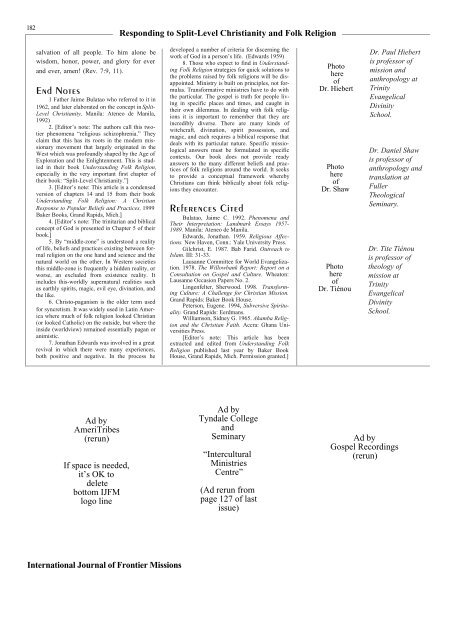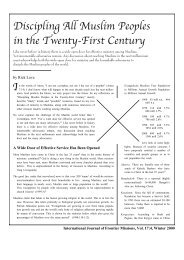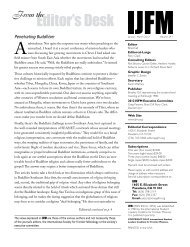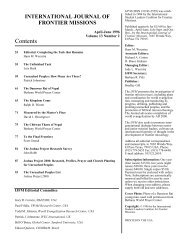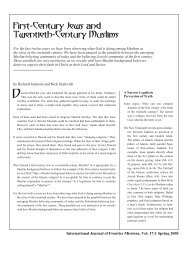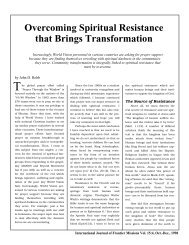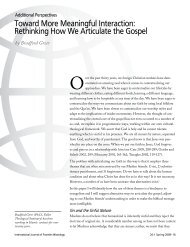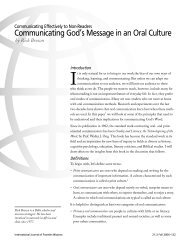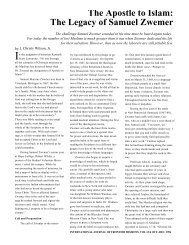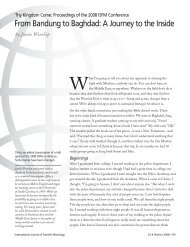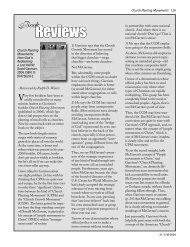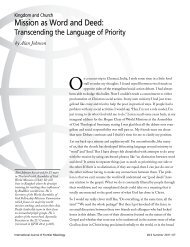Responding to Split-Level Christianity and Folk Religion
Responding to Split-Level Christianity and Folk Religion
Responding to Split-Level Christianity and Folk Religion
Create successful ePaper yourself
Turn your PDF publications into a flip-book with our unique Google optimized e-Paper software.
182<strong>Responding</strong> <strong>to</strong> <strong>Split</strong>-<strong>Level</strong> <strong>Christianity</strong> <strong>and</strong> <strong>Folk</strong> <strong>Religion</strong>salvation of all people. To him alone bewisdom, honor, power, <strong>and</strong> glory for ever<strong>and</strong> ever, amen! (Rev. 7:9, 11).End Notes1 Father Jaime Bulatao who referred <strong>to</strong> it in1962, <strong>and</strong> later elaborated on the concept in <strong>Split</strong>-<strong>Level</strong> <strong>Christianity</strong>, Manila: Ateneo de Manila,1992)2. [Edi<strong>to</strong>r’s note: The authors call this twotierphenomena “religious schizophrenia.” Theyclaim that this has its roots in the modern missionarymovement that largely originated in theWest which was profoundly shaped by the Age ofExploration <strong>and</strong> the Enlightenment. This is studiedin their book Underst<strong>and</strong>ing <strong>Folk</strong> <strong>Religion</strong>,especially in the very important first chapter oftheir book: “<strong>Split</strong>-<strong>Level</strong> <strong>Christianity</strong>.”]3. [Edi<strong>to</strong>r’s note: This article is a condensedversion of chapters 14 <strong>and</strong> 15 from their bookUnderst<strong>and</strong>ing <strong>Folk</strong> <strong>Religion</strong>: A ChristianResponse <strong>to</strong> Popular Beliefs <strong>and</strong> Practices, 1999Baker Books, Gr<strong>and</strong> Rapids, Mich.]4. [Edi<strong>to</strong>r’s note: The trinitarian <strong>and</strong> biblicalconcept of God is presented in Chapter 5 of theirbook.]5. By “middle-zone” is unders<strong>to</strong>od a realityof life, beliefs <strong>and</strong> practices existing between formalreligion on the one h<strong>and</strong> <strong>and</strong> science <strong>and</strong> thenatural world on the other. In Western societiesthis middle-zone is frequently a hidden reality, orworse, an excluded from existence reality. Itincludes this-worldly supernatural realities suchas earthly spirits, magic, evil eye, divination, <strong>and</strong>the like.6. Chris<strong>to</strong>-paganism is the older term usedfor syncretism. It was widely used in Latin Americawhere much of folk religion looked Christian(or looked Catholic) on the outside, but where theinside (worldview) remained essentially pagan oranimistic.7. Jonathan Edwards was involved in a greatrevival in which there were many experiences,both positive <strong>and</strong> negative. In the process hedeveloped a number of criteria for discerning thework of God in a person’s life. (Edwards 1959)8. Those who expect <strong>to</strong> find in Underst<strong>and</strong>ing<strong>Folk</strong> <strong>Religion</strong> strategies for quick solutions <strong>to</strong>the problems raised by folk religions will be disappointed.Ministry is built on principles, not formulas.Transformative ministries have <strong>to</strong> do withthe particular. The gospel is truth for people livingin specific places <strong>and</strong> times, <strong>and</strong> caught intheir own dilemmas. In dealing with folk religionsit is important <strong>to</strong> remember that they areincredibly diverse. There are many kinds ofwitchcraft, divination, spirit possession, <strong>and</strong>magic, <strong>and</strong> each requires a biblical response thatdeals with its particular nature. Specific missiologicalanswers must be formulated in specificcontexts. Our book does not provide readyanswers <strong>to</strong> the many different beliefs <strong>and</strong> practicesof folk religions around the world. It seeks<strong>to</strong> provide a conceptual framework wherebyChristians can think biblically about folk religionsthey encounter.References CitedBulatao, Jaime C. 1992. Phenomena <strong>and</strong>Their Interpretation: L<strong>and</strong>mark Essays 1957-1989. Manila: Ateneo de Manila.Edwards, Jonathan. 1959. Religious Affections.New Haven, Conn.: Yale University Press.Gilchrist, E. 1987. Bab Farid. Outreach <strong>to</strong>Islam. III: 31-33.Lausanne Committee for World Evangelization.1978. The Willowbank Report: Report on aConsultation on Gospel <strong>and</strong> Culture. Whea<strong>to</strong>n:Lausanne Occasion Papers No. 2.Lingenfelter, Sherwood. 1998. TransformingCulture: A Challenge for Christian Mission.Gr<strong>and</strong> Rapids: Baker Book House.Peterson, Eugene. 1994, Subversive Spirituality.Gr<strong>and</strong> Rapids: Eerdmans.Williamson, Sidney G. 1965. Akamba <strong>Religion</strong><strong>and</strong> the Christian Faith. Accra: Ghana UniversitiesPress.[Edi<strong>to</strong>r’s note: This article has beenextracted <strong>and</strong> edited from Underst<strong>and</strong>ing <strong>Folk</strong><strong>Religion</strong> published last year by Baker BookHouse, Gr<strong>and</strong> Rapids, Mich. Permission granted.]Pho<strong>to</strong>hereofDr. HiebertPho<strong>to</strong>hereofDr. ShawPho<strong>to</strong>hereofDr. TiénouDr. Paul Hiebertis professor ofmission <strong>and</strong>anthropology atTrinityEvangelicalDivinitySchool.Dr. Daniel Shawis professor ofanthropology <strong>and</strong>translation atFullerTheologicalSeminary.Dr. Tite Tiénouis professor oftheology ofmission atTrinityEvangelicalDivinitySchool.Ad byAmeriTribes(rerun)If space is needed,it’s OK <strong>to</strong>deletebot<strong>to</strong>m IJFMlogo lineAd byTyndale College<strong>and</strong>Seminary“InterculturalMinistriesCentre”(Ad rerun frompage 127 of lastissue)Ad byGospel Recordings(rerun)International Journal of Frontier Missions


